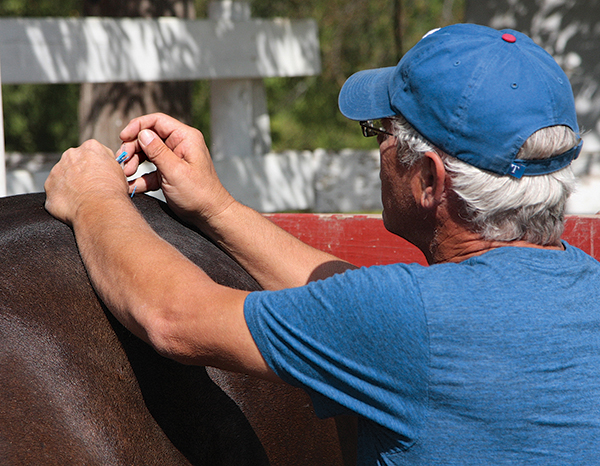Have you tried alternative health therapies with your horses? Many owners have, finding them useful for a variety of therapeutic purposes. Here’s a summary of three of the most popular alternatives, from Barb Crabbe, DVM, H&R’s consulting veterinarian and author of The Comprehensive Guide to Equine Veterinary Medicine.
Acupuncture
The therapy: Tiny needles inserted at specific locations along your horse’s body. Developed by the ancient Chinese, acupuncture is now known to access areas particularly rich in nerve endings and/or blood vessels. Needles placed in these locations cause the release of neurotransmitters and other local factors, leading to body-wide therapeutic effects.
[READ: Complementary Care for the Traveling Horse]

Potential benefits: Can be helpful if your horse is muscle-sore from performance or from compensating for an injury elsewhere, or if he’s suffering back pain. Acupuncture can also help control allergy symptoms (hives, skin rashes, cough); relieve jaw pain following dental procedures; and help quiet intestinal spasms related to colic. In broodmares having difficulty cleaning themselves out, acupuncture can lead to smooth-muscle contractions that help clear fluid from the uterus.
Providers: Typically veterinarians who’ve completed credentialing programs with one of three organizations: the Chi Institute (tcvm.com), the Colorado-based Medical Acupuncture for Veterinarians (colovma.org), or the International Veterinary Acupuncture Society (ivas.org).
Chiropractic
The therapy: Manipulation of the bones to restore proper alignment of the vertebrae or other joints when they’ve been disrupted. Such disruption, or “subluxation,” can impact nerves, muscles, and joints in the surrounding area, causing pain or discomfort. A subluxation may even disrupt the nerve supply and/or blood flow to internal organs.
Potential benefits: Can be particularly useful for back pain, especially if your horse has a visible asymmetry, such as a head tilt, traveling crookedly, or carrying his tail to one side. Stiffness and training issues that aren’t associated with apparent lameness often respond well to chiropractic therapy.
Providers: Veterinarians or equine chiropractors certified by the American Veterinary Chiropractic Association (animalchiropractic.org or avcadoctors.com), the most widely recognized certifying group in the U.S.
Massage/Body Work
The therapy: Hands-on manipulation of muscles to help improve circulation, relieve muscle spasms, and increase range of motion. Techniques include massage, stretches, and other exercises.
[READ: Stretches for Horses]

Potential benefits: Like acupuncture, massage therapy can help minimize performance-related muscular soreness and compensatory soreness from illness or injury. Massage therapists often use acupuncture locations as trigger points in their work.
Providers: Unlike acupuncture and chiropractic, massage-therapy training programs don’t require participants to be veterinarians, and many different programs of varying rigor offer “certificates” for coursework completion—so it’s “consumer beware.” One organization to look for, when you ask about credentials, is the International Equine Body Workers Association (iebwa.com). It calls for at least 150 hours of coursework from a recognized school, plus a hands-on test and other requirements.






